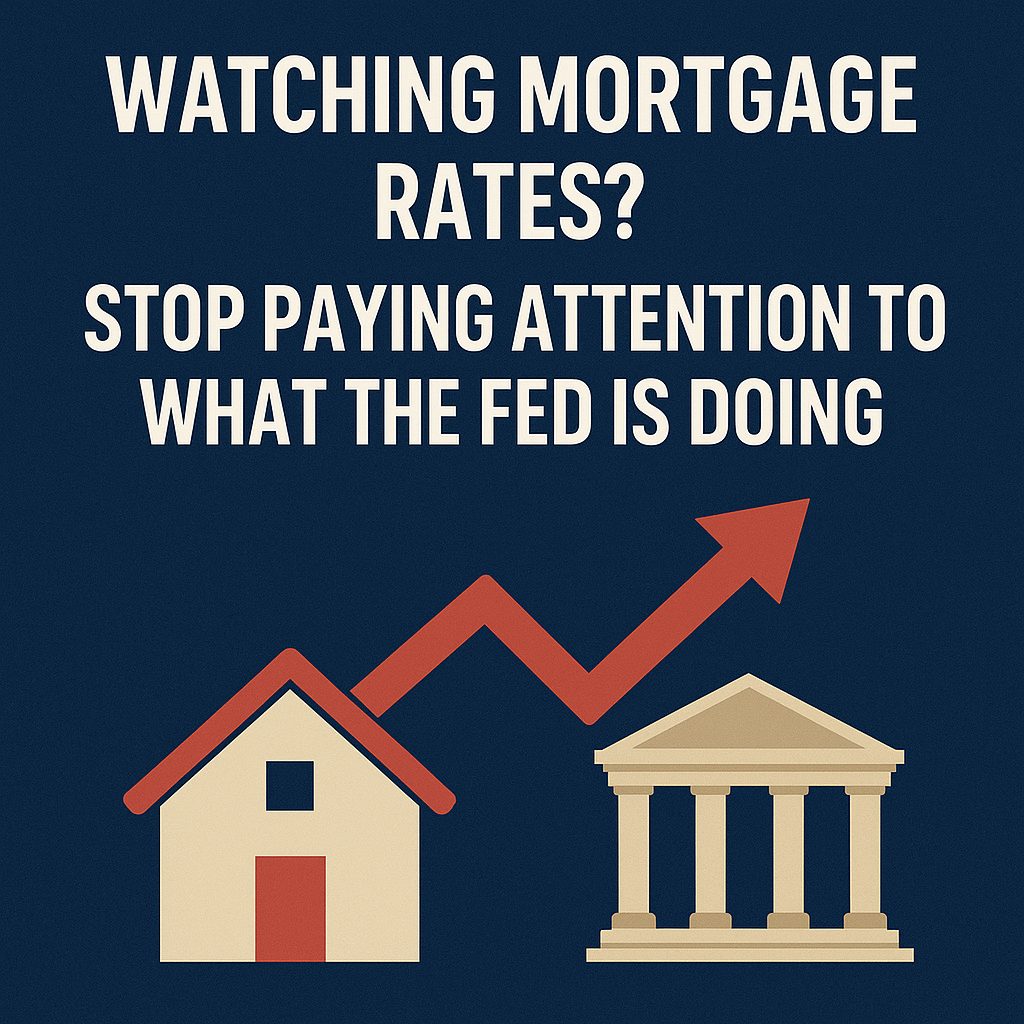The Fed Doesn’t Control Mortgage Rates Like You Think
Many people believe that mortgage rates go up or down depending on what the Federal Reserve does. That’s only partly true. The Fed sets short-term interest rates, like the federal funds rate, but mortgage rates are tied more closely to the 10-year U.S. Treasury bond.
While the Fed can influence the economy and investor mood, mortgage rates change for other reasons too. If you want to understand where mortgage rates are headed, you need to look beyond the Fed.
👉 Learn more about how the Federal Reserve influences interest rates (Investopedia)
What Really Drives Mortgage Rates
1. The 10-Year Treasury Yield
The 10-year Treasury bond is the main indicator for mortgage rates. Most lenders use it to help set mortgage pricing. They add a margin on top to cover their costs and risks.
This bond matters because most people sell or refinance their home within 10 years. That’s why lenders care more about this bond than the Fed’s rate.
When investors want safety, they buy Treasury bonds. This pushes yields down. When they expect strong growth or inflation, they sell bonds, and yields rise. As yields rise, so do mortgage rates.
👉 View the current 10-year Treasury yield (CNBC)
2. Inflation Expectations
Inflation hurts fixed investments like bonds. When prices go up, the money investors earn from bonds is worth less. So they want higher yields to make up for that.
As inflation rises, so do bond yields—and mortgage rates go up too, even if the Fed doesn’t change anything.
👉 Track real-time U.S. inflation data (U.S. Bureau of Labor Statistics)
3. Global Investment Trends
Money moves around the world. When there’s trouble in other countries, investors often buy U.S. bonds for safety. That pushes yields down, which lowers mortgage rates.
When money flows out of U.S. bonds, yields go up. This can happen because of global news, trade tensions, or foreign central bank actions. These global shifts can impact your mortgage more than the Fed.
👉 See how geopolitical risk affects mortgage markets (Mortgage Bankers Association)
4. Demand for Mortgage-Backed Securities (MBS)
After the 2008 crash, the Fed bought a lot of MBS to help keep mortgage rates low. Now, the Fed is pulling back from buying MBS. That means fewer buyers and higher rates.
With less demand, investors want more return. That leads lenders to raise mortgage rates.
👉 Understand the Fed’s balance sheet and MBS role (Federal Reserve)
5. Lender Risk and Behavior
Mortgage lenders also look at risk in the housing market. If they expect more missed payments, they raise rates to protect themselves.
Also, banks have to follow strict rules. These rules affect how they lend and at what cost. Even when the Fed lowers rates, lenders might not pass on the savings if they’re worried about risk or profit.
👉 Read more on how lenders set mortgage rates (NerdWallet)
Why Watching the Fed Can Lead You Astray
Many buyers think they should wait for the Fed to lower rates. But this is risky. The Fed doesn’t control everything. In fact, mortgage rates may stay high or even rise, even if the Fed cuts rates.
In 2020 and 2021, rates dropped into the 2–3% range. But that wasn’t just the Fed. That drop was due to COVID, panic buying of bonds, and emergency economic policies. That time was unique. We’re not going back to that environment anytime soon.
A Smarter Way to Think About Mortgage Rates
Make Decisions Based on Your Situation
Instead of waiting for rates to fall, ask:
-
Can I afford the payment now?
-
Will this home help me build equity?
-
Is this a smart long-term move?
If yes, don’t wait. Trying to time the market is risky and can lead to missed opportunities.
Use Tools to Help with Higher Rates
Many lenders offer rate buydown programs, help with closing costs, or adjustable-rate mortgages with lower starting rates. These tools can help you afford a home now and refinance later if rates drop.
👉 Learn more about mortgage rate buydowns and how they work
Marry the House, Date the Rate
You may have heard this phrase—and it’s smart advice. Buy the right home when it’s available. You can always refinance later. But if you wait, you could lose the house, miss out on equity growth, or face higher prices.
The Big Picture: Mortgage Rates Are Changing for New Reasons
The world is different now. The Fed isn’t the only player anymore. Today, mortgage rates depend more on bond markets, inflation, global events, and lender risk than on Fed actions.
Understanding these factors gives you power. It helps you make better decisions in today’s housing market.
Key Points to Remember:
-
Mortgage rates follow the 10-year Treasury, not the Fed rate.
-
Inflation and global markets have a bigger impact than you might think.
-
Waiting for the Fed can lead to missed chances.
-
Smart tools and strategies can help you buy now.
-
Focus on your needs and goals, not headlines.
Conclusion: Stop Watching the Fed, Start Understanding the Market
Don’t let the Fed’s moves—or the media’s take on them—be your guide. Learn what truly drives mortgage rates so you can make smart choices today. The best time to buy is when you’re ready, not when the Fed makes a headline.


 Facebook
Facebook
 X
X
 Pinterest
Pinterest
 Copy Link
Copy Link

